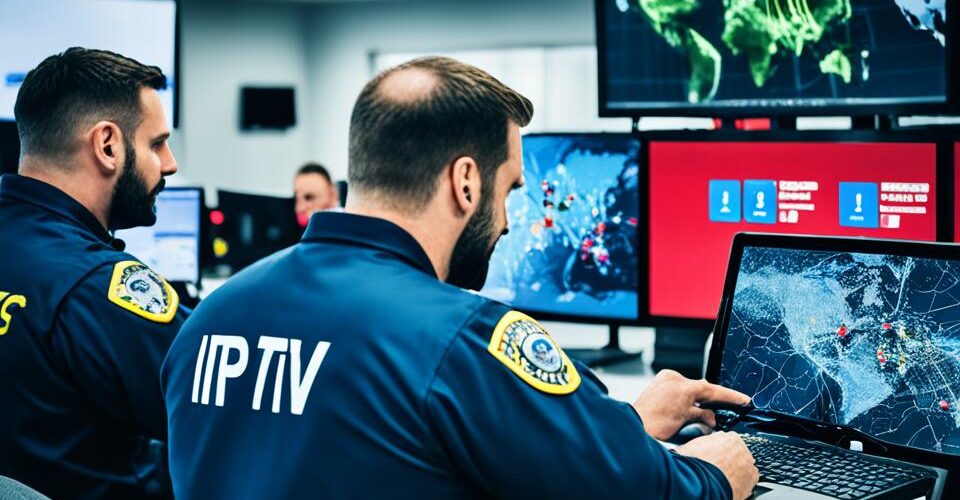Did you know that the deployment of IPTV technology in crisis management has become a game-changer in improving emergency broadcasting and public safety? IPTV, or Internet Protocol Television, has revolutionized the way emergency management teams respond to disasters, providing advanced communication solutions and enabling efficient emergency alert systems.
With the increasing frequency and volatility of natural hazards such as wildfires, floods, hurricanes, and tornadoes, the need for effective crisis communication and emergency preparedness has never been greater. IPTV, along with other communication technologies, plays a crucial role in enhancing situational awareness for first responders, improving resource utilization, and ensuring the safety and security of personnel.
In this article, we will explore the evolution of Intelligence Surveillance and Reconnaissance (ISR) technologies in emergency management, the impact of ISR technologies on emergency response, the integration of ISR technologies into emergency management operations, and the leveraging of IPTV for emergency management missions. We will also discuss the power of digital signage in emergency communication, the future of IPTV and crisis management, and much more.
Key Takeaways:
- IPTV technology has revolutionized emergency broadcasting and public safety
- ISR technologies play a significant role in enhancing emergency response
- The integration of ISR technologies and IPTV in emergency management operations improves coordination and preparedness for major catastrophic events
- VITEC, a leading provider of video solutions, offers advanced IPTV technologies for emergency management missions
- Digital signage systems are effective tools for emergency communication and enhancing public safety
Evolution of ISR Technologies in Emergency Management
The application of ISR technologies in emergency management has undergone significant advancements in recent years. As the frequency and severity of disasters increase, the need for effective intelligence surveillance and reconnaissance solutions has become paramount. Technology developers and field operators have collaborated to adapt and refine ISR platforms to meet the evolving requirements of emergency response.
ISR technologies have transformed into highly capable and versatile tools, equipped with innovative features and functionalities. The emergency management community has embraced these advancements, relying on the expertise of both experienced field operators and former military personnel who have transitioned to first-responder careers. Their practical knowledge and familiarity with ISR toolsets have enhanced the adoption and utilization of these technologies in real-world emergency scenarios.
The rising occurrence of major catastrophic incidents, including natural disasters and terrorist threats, has further amplified the urgency to incorporate ISR technologies into emergency response strategies. The ability to gather real-time intelligence, monitor critical situations, and make informed decisions has proven instrumental in improving the effectiveness and efficiency of emergency management operations.
As technology continues to evolve, a wide range of ISR technologies is being developed and deployed, catering to the specific needs of emergency management. These developments include advancements in unmanned aerial vehicles (UAVs), sensor technologies, data analytics, and communication systems. The integration of these technologies has revolutionized situational awareness, resource allocation, and coordination efforts in emergency response.
Benefits of ISR Technologies in Emergency Management:
- Enhanced Situational Awareness: ISR technologies provide real-time data and imagery, enabling field operators to swiftly assess and understand the circumstances surrounding an emergency. This enhanced awareness guides decision-making and facilitates more targeted and effective response efforts.
- Improved Resource Utilization: By leveraging ISR technologies, emergency management teams can optimize the allocation and deployment of resources, such as personnel, equipment, and supplies. This ensures that resources are utilized efficiently, saving time and potentially saving lives.
- Efficient Communication Networks: ISR technologies enable seamless communication between field operators, emergency management centers, and other stakeholders involved in the response efforts. The integration of communication systems improves coordination and enables timely and effective dissemination of critical information.
- Effective Incident Command: ISR technologies provide field operators and incident commanders with real-time data and situational awareness, enabling them to make informed decisions and establish effective incident command structures. This streamlines the chain of command and ensures a coordinated response.
Table: Evolution of ISR Technologies in Emergency Management
| Technology | Key Advancements |
|---|---|
| Unmanned Aerial Vehicles (UAVs) | Integration of high-resolution imaging sensors, improved flight endurance, and enhanced autonomous capabilities. |
| Surveillance Systems | Development of sophisticated video analytics, real-time object detection, and tracking algorithms. |
| Data Analytics | Integration of advanced machine learning algorithms for data processing, anomaly detection, and predictive analytics. |
| Communication Systems | Improved interoperability, encryption, and data transmission capabilities for seamless communication in emergency scenarios. |
With the continuous evolution of ISR technologies, emergency management organizations are better equipped to respond to emergencies and safeguard public safety. The integration of these technologies, along with the expertise of field operators and the commitment of technology developers, continues to enhance the efficiency and effectiveness of emergency response efforts.
The Impact of ISR Technologies on Emergency Response
ISR technologies have a significant impact on emergency response. First responders, driven by their concern for public safety, rely on these technologies to mitigate risks and quickly reach people endangered by catastrophic events. By providing critical awareness on the ground through unmanned ground vehicles and from above via helicopters, airplanes, and drones, ISR technologies gather large amounts of data to alert response teams about imminent dangers and provide crucial context for decision-making.
These technologies enable first responders to make informed decisions rapidly, based on real-time data. Whether it’s assessing the structural integrity of a building, monitoring the spread of a wildfire, or searching for survivors in challenging terrains, ISR technologies empower first responders with actionable intelligence.
Key benefits of ISR technologies in emergency response:
- Enhanced situational awareness: ISR technologies provide real-time data from multiple sources, enabling first responders to understand the evolving dynamics of an emergency and make informed decisions.
- Improved resource allocation: By gathering data on the location and severity of an emergency, ISR technologies help allocate resources more effectively, ensuring that first responders are deployed where they are needed most.
- Enhanced communication: ISR technologies enable seamless communication between first responders, allowing for coordinated efforts and rapid action.
- Reduced risk to first responders: By providing critical information about hazards, potential threats, and the environment, ISR technologies help protect the health and safety of first responders.
The integration of high-quality data into emergency response strategies has proven to be crucial in saving lives and minimizing the impact of disasters. When every second counts, the ability to gather and analyze data rapidly can make all the difference in executing effective rescue and recovery efforts.

Integration of ISR Technologies into Emergency Management Operations
The integration of ISR technologies into emergency management operations is a top priority for the emergency management community. However, the successful adoption of these technologies often depends on the budget constraints and maturity of individual state and local government agencies. Despite these challenges, the benefits of integrating ISR technologies into emergency management operations are significant.
One key factor in successful integration is the level of involvement and collaboration between civilian emergency management communities and national guard units with ISR capabilities. By developing ongoing relationships and conducting joint exercises with national guard units, local emergency management agencies can enhance their preparedness and coordination for major catastrophic events.
Coordinated responses between civilian and military entities are crucial in ensuring an efficient joint response to emergencies. ISR technologies play a vital role in facilitating effective coordination by providing real-time data and situational awareness to emergency management teams. These technologies enable better resource allocation, improved communication networks, and enhanced decision-making capabilities.
To illustrate the importance of integration, the following table highlights the key advantages of integrating ISR technologies into emergency management operations:
| Advantages of Integration | Description |
|---|---|
| Enhanced Situational Awareness | ISR technologies provide real-time data and intelligence to emergency management teams, enabling them to make informed decisions and take rapid action. |
| Improved Resource Utilization | By leveraging ISR technologies, emergency management agencies can optimize the allocation of resources, ensuring that they are directed to areas with the greatest need. |
| Effective Communication Networks | ISR technologies enable the establishment of robust communication networks, facilitating seamless coordination between different response units. |
| Coordinated Responses | Through joint exercises and collaboration with national guard units, civilian emergency management agencies can enhance their coordinated response capabilities during major catastrophic events. |
The Role of Joint Exercises in Integration
Joint exercises play a critical role in integrating ISR technologies into emergency management operations. These exercises provide an opportunity for civilian and military entities to train together, share best practices, and develop unified response plans. By conducting joint exercises, both civilian and military personnel can gain a better understanding of each other’s capabilities, limitations, and operational procedures.
Furthermore, joint exercises offer an environment for testing and evaluating the interoperability of different ISR technologies and communication systems. Identifying any potential issues or gaps in interoperability early on allows for adjustments to be made before an actual emergency occurs.
Through joint exercises, the emergency management community can foster stronger relationships with national guard units and leverage their expertise in ISR technologies. This collaboration enhances the overall effectiveness and efficiency of emergency response efforts, ensuring the safety and well-being of communities in times of crisis.
Leveraging IPTV for Emergency Management Missions
In today’s rapidly evolving emergency management landscape, the integration of advanced technologies is crucial for enhancing public safety and improving response strategies. VITEC, a leading provider of video solutions, has partnered with the US Department of Defense and NATO partners to leverage the power of IPTV technology in emergency management missions.
VITEC’s IPTV solutions are built with military-grade security and adaptability, making them ideal for challenging environments. These cutting-edge streaming solutions offer end-to-end capabilities, enabling seamless communication and data sharing between emergency management centers and field operations. By utilizing IPTV technology, emergency management leaders can consolidate multiple data sources, enabling informed decision-making and enhanced public safety.
The versatility of VITEC’s IPTV solutions allows for deployment on various platforms, including tanks, helicopters, and drones. These technologies are compatible with complex communication networks and satellite systems, ensuring reliable and uninterrupted streaming capabilities in critical situations.
Benefits of VITEC’s IPTV Solutions for Emergency Management
VITEC’s IPTV solutions offer several key advantages for emergency management missions:
- Military-grade security: Protect sensitive information and ensure secure communication during emergency operations.
- End-to-end streaming: Streamline communication and data sharing between emergency management centers and field operations.
- Compatibility with complex networks: Seamlessly integrate with existing communication networks, satellite systems, and other technologies.
- Adaptability to challenging environments: Deploy IPTV solutions on various platforms, including tanks, helicopters, and drones.
By leveraging VITEC’s IPTV solutions, emergency management teams can achieve unparalleled situational awareness and communication capabilities, ultimately leading to more efficient emergency responses and enhanced public safety.

Case Study: Successful Deployment of VITEC’s IPTV Solutions
| Organization | Location | Deployment |
|---|---|---|
| US Department of Defense | Various locations worldwide | Tanks, helicopters, and drones |
| Emergency Management Centers | Nationwide | Facility-wide streaming solutions |
The successful deployment of VITEC’s IPTV solutions has been demonstrated through partnerships with the US Department of Defense and emergency management centers nationwide. Various platforms, including tanks, helicopters, and drones, have effectively utilized VITEC’s advanced technologies for improved emergency response.
With its commitment to military-grade security, adaptability, and end-to-end streaming capabilities, VITEC continues to revolutionize emergency management missions through IPTV technology. The future of emergency response will be further enhanced as VITEC and its partners drive the development of innovative solutions to meet the evolving needs of public safety.
Leveraging IPTV for Emergency Alerts and Public Safety
The same technology that enables a moment of exclusivity (MOE) for advertising purposes in sports venues can be leveraged for emergency alerts and enhanced public safety. IPTV and digital signage systems with ultra-low-latency and synchronized playback capabilities, coupled with API integration, allow operators to effectively control every screen within a facility. This enables the dissemination of critical information to the public during emergencies. The use of IPTV and digital signage for emergency communication, including wayfinding and alerts, ensures that venues can quickly inform and instruct guests during unexpected events, making the technology a valuable tool for public safety.
| Benefits of Leveraging IPTV for Emergency Alerts and Public Safety |
|---|
| Enhanced Public Safety |
| Effective dissemination of critical information |
| Quickly inform and instruct guests during emergencies |
| Multi-purpose technology for emergency communication |
| Improved response time and coordination |
Case Study: Utilizing Digital Signage in Chase Center
The Chase Center in San Francisco, home to the Golden State Warriors, showcases the practical application of digital signage in enhancing public safety. The venue’s large size and limited parking can pose challenges, especially during high-attendance events. This is where digital signage plays a crucial role in guiding guests quickly and safely to the correct exits, improving venue navigation and ensuring a seamless experience.

To optimize the effectiveness of digital signage in emergency situations, operators at Chase Center leverage the same technology used to trigger moment of exclusivity (MOE) events. This allows them to customize screens with critical wayfinding signage following game-day events. By strategically placing digital signage throughout the venue and utilizing real-time updates, guests are promptly informed of the most efficient routes for exiting the premises during unexpected events.
The versatility and effectiveness of digital signage in emergency situations is exemplified by the way it enhances public safety at Chase Center. The integration of this technology sets a precedent for other sports venues and entertainment arenas, showcasing the impact that digital signage can have in ensuring the well-being of guests and staff.
The Role of Digital Signage in Emergency Communication
While static signage and audio integration have traditionally been the focus of emergency communication plans, digital signage should not be overlooked. The right IPTV and digital signage system can quickly inform and guide people during emergencies. By integrating with a venue’s Emergency Communication System (ECS) or Mass Notification System, digital signage can override regular programming and provide visual instructions to every screen simultaneously. This one-button control ensures that critical information reaches the public immediately and enhances the overall effectiveness of emergency communication efforts.
Benefits of Digital Signage in Emergency Communication:
- Highly visible signage: Digital signage displays bold and eye-catching visuals, ensuring that emergency messages are easily seen and understood by the public.
- Audio integration: Digital signage can be equipped with audio capabilities to complement visual instructions, providing clear and concise information during emergencies.
- Mass notification systems: By integrating with a venue’s ECS or Mass Notification System, digital signage can disseminate emergency messages to multiple screens simultaneously, reaching a wide audience quickly.
- One-button control: Digital signage systems can be easily controlled with a single button, allowing operators to swiftly override regular programming and display emergency instructions, ensuring immediate communication with the public.
During crisis intervention plans, digital signage serves as a powerful tool for emergency communication. Its visual impact, audio integration, and ability to synchronously provide instructions across multiple screens make it an invaluable asset in enhancing public safety. By leveraging the capabilities of digital signage, venues and organizations can effectively guide and inform individuals during emergencies, minimizing panic and facilitating a prompt and coordinated response.
Real-life Scenario: Utilizing Digital Signage in a Major Stadium
In a major stadium, digital signage played a crucial role in ensuring public safety during a sudden evacuation. When a severe weather alert was issued, the venue’s ECS integrated with the digital signage system, triggering a mass override of regular programming. Within seconds, every screen in the stadium displayed clear instructions for evacuation routes and emergency exits. The highly visible and synchronized messages guided spectators to safety, avoiding confusion and ensuring a swift and efficient evacuation.
Leveraging Digital Signage for Visual Communication
Just as operators can trigger moment of exclusivity (MOE) events, venues can leverage their digital signage systems to visually communicate information during emergencies. By customizing screens and utilizing the same technology employed during MOE events, venues can display vital instructions or emergency alerts to every screen simultaneously. This immediate visual communication ensures that the public receives critical information and guidance without delay, enhancing public safety and response efforts.
Screen Customization for Emergency Alerts
During emergencies, the ability to convey information quickly and effectively is crucial. Digital signage allows venues to customize their screens to display emergency alerts in a visually compelling manner. With the use of vibrant colors, bold typography, and attention-grabbing graphics, digital signage ensures that emergency messages are easily noticed by the public. Whether it’s a severe weather warning or an evacuation notice, visually appealing and well-designed screens attract attention and prompt immediate action.
Visual Instruction and Guidance
In emergency situations, clear and concise instructions are paramount to ensuring the safety of the public. Digital signage provides a powerful platform for delivering visual instruction and guidance. By utilizing images and symbols, venues can convey information that is easily understood, even in high-stress situations. Whether it’s directing people to emergency exits or providing guidance on first aid procedures, digital signage ensures that crucial information is communicated effectively and efficiently.
Enhanced Emergency Alerts through Override Programming
In emergency scenarios, it is crucial to override regular programming and ensure that emergency alerts take precedence on every screen throughout a venue. Digital signage systems can be programmed to automatically interrupt regular content and display emergency alerts, ensuring that critical information is seen by everyone. By leveraging override programming, venues can quickly disseminate emergency alerts, improving situational awareness and enabling swift response from the public.
Sample Table: Benefits of Leveraging Digital Signage for Visual Communication
| Benefit | Description |
|---|---|
| Enhanced Visibility | Visual communication through digital signage ensures that emergency messages are easily noticed and understood. |
| Improved Response Time | Clear visual instructions on digital signage prompt immediate action, reducing response time in emergency situations. |
| Wide-reaching Communication | Utilizing digital signage allows venues to communicate emergency alerts to a large audience simultaneously. |
| Flexibility and Customization | Digital signage systems can be customized to display specific instructions or alerts tailored to the emergency at hand. |
| Efficient Override Programming | Override programming ensures that emergency alerts take precedence over regular content and are displayed on every screen. |
The Power of Preparation and Integration
For sports teams and venue operators, creating a memorable experience for fans goes beyond the game itself. It also includes prioritizing public safety and emergency preparedness. Utilizing digital signage systems and processes designed for every event, from wayfinding to advertising, allows venues to seamlessly integrate emergency communication efforts. By leveraging the same technology used for regular operations, venues can effectively prepare for unexpected events and alleviate the burden of ensuring public safety. Every moment counts, and being well-prepared enhances both the experience and safety of fans.
Enhancing Public Safety Through Preparation
When it comes to hosting large-scale events, sports teams and venue operators understand the importance of thorough preparation. By proactively implementing emergency preparedness measures, they can prioritize public safety and ensure a smooth and enjoyable fan experience. Digital signage systems play a crucial role in this process, providing a versatile platform for enhancing emergency communication.
By leveraging digital signage systems, sports venues can:
- Display emergency instructions and evacuation routes
- Provide real-time updates and information during crises
- Coordinate with emergency responders and convey critical messages
- Ensure quick and efficient communication with patrons
This level of preparedness not only instills a sense of security among fans but also demonstrates the commitment of sports teams and venue operators to their well-being.
Seamless Integration for Effective Emergency Communication
One of the key advantages of using digital signage systems for emergency communication is their ability to seamlessly integrate with existing venue processes. This integration ensures that emergency communication efforts are streamlined and efficient, without causing disruptions to regular operations.
By leveraging the same technology used for regular signage and advertising, sports teams and venue operators can:
- Utilize familiar software and hardware systems
- Reduce the need for additional investments in specialized emergency communication technologies
- Train staff on a single platform for both regular and emergency communication
- Maximize the effectiveness of existing digital signage infrastructure
This integration not only simplifies emergency communication processes but also ensures consistency and accuracy in conveying critical messages to fans in times of crisis.
The Impact on Fan Experience and Public Safety
By prioritizing public safety and leveraging digital signage systems for emergency preparedness, sports teams and venue operators enhance both the fan experience and overall public safety. Whether it’s notifying fans about potential hazards, providing real-time updates during emergencies, or guiding evacuations, digital signage plays a crucial role in keeping fans informed and protected.
Furthermore, the integration of digital signage systems into emergency preparedness strategies helps maintain calm and order during crises. Clear and timely communication allows fans to make informed decisions and take necessary actions, reducing panic and ensuring a swift and organized response.
Ultimately, the power of preparation and integration lies in its ability to create a safe and enjoyable environment for fans while also demonstrating a commitment to their well-being.
The Future of IPTV and Crisis Management
The future of IPTV and Crisis Management holds great promise for enhanced public safety and improved disaster response strategies. As technology continues to evolve, innovations in IPTV, digital signage, and communication systems will further advance emergency broadcasting and public safety efforts. The integration of emerging technologies, such as artificial intelligence and real-time data analytics, will enable more sophisticated decision-making during emergencies. The focus on seamless integration, interoperability, and user-friendly interfaces will ensure that these technologies are accessible and effective for emergency management teams.
Emerging technologies are poised to transform the field of emergency management, revolutionizing the way disasters are addressed and public safety is ensured. By leveraging advancements in IPTV, digital signage, and communication systems, emergency response teams will have access to a wide array of tools and resources designed to enhance their capabilities and improve their response strategies.
Predictive Analytics and Real-Time Data
- Advanced analytics algorithms can analyze vast amounts of data in real-time, providing critical insights and predictions on the spread and impact of disasters.
- These insights enable emergency management teams to allocate resources strategically, anticipate needs, and make informed decisions that enhance public safety.
- Real-time data feeds can be integrated into IPTV systems and digital signage, providing up-to-date information and alerts to the public during emergencies.
Smart Sensor Technology
- Smart sensors can monitor critical infrastructure, environmental conditions, and various hazards, providing real-time data on potential risks and threats.
- IPTV platforms can integrate with smart sensor networks, allowing emergency management teams to receive automated alerts and respond to incidents more efficiently.
- These sensors can also provide valuable data for post-incident analysis, helping to improve future disaster response strategies.
Enhanced Communication and Collaboration
- Improved communication systems, including advanced two-way radios and IoT-connected devices, enable seamless communication between emergency responders and the public.
- IPTV can serve as a central platform for sharing real-time information, coordinating response efforts, and disseminating critical instructions to both the public and response teams.
- Collaboration tools and platforms can facilitate effective coordination between multiple agencies, enabling a unified and efficient response.
Drone Technology
- Drones equipped with sensors, cameras, and communication capabilities can provide valuable situational awareness and aerial imagery during disasters.
- IPTV systems can integrate with drone technology, allowing emergency management teams to receive live video feeds and conduct remote assessments of impacted areas.
- These capabilities aid in decision-making, resource allocation, and the identification of areas that require immediate attention.
The future of IPTV and Crisis Management is bright, with exciting developments on the horizon. As technology continues to advance, emergency management teams will benefit from enhanced tools and resources that improve public safety, enable more efficient disaster response strategies, and save lives.
Conclusion
IPTV and Crisis Management are essential for revolutionizing emergency broadcasting and enhancing public safety. The evolution of ISR technologies, such as IPTV, along with the integration of IPTV and digital signage systems, has significantly improved emergency response efforts. By leveraging these technologies, sports venues, entertainment arenas, and emergency management organizations can effectively inform and guide the public during emergencies, reducing risks and ensuring maximum public safety.
With the continuous advancements in IPTV and Crisis Management, the future holds immense potential for enhancing disaster response and protecting communities. The integration of emerging technologies, such as artificial intelligence and real-time data analytics, will further improve decision-making during emergencies. The focus on seamless integration, interoperability, and user-friendly interfaces will ensure that these technologies are easily accessible and effective for emergency management teams.
Overall, IPTV and Crisis Management are instrumental in transforming emergency broadcasting and public safety. By harnessing the power of these technologies, emergency response efforts can be streamlined, ensuring timely and accurate information dissemination during critical incidents. As technology continues to evolve and innovate, IPTV and Crisis Management will play a critical role in safeguarding lives and minimizing the impact of disasters on communities.
FAQ
What is the role of IPTV and Crisis Management in emergency broadcasting and public safety?
How have ISR technologies evolved in emergency management?
What impact do ISR technologies have on emergency response?
How can ISR technologies be integrated into emergency management operations?
How is IPTV being leveraged for emergency management missions?
How can IPTV and digital signage systems enhance emergency alerts and public safety?
Can you provide a case study of utilizing digital signage in enhancing public safety?
What is the role of digital signage in emergency communication?
How can digital signage be leveraged for visual communication during emergencies?
How does preparation and integration play a role in public safety and emergency preparedness?
What does the future hold for IPTV and Crisis Management?
How do IPTV and Crisis Management contribute to emergency broadcasting and public safety?






